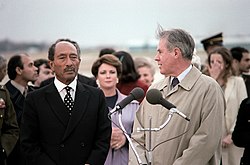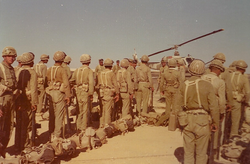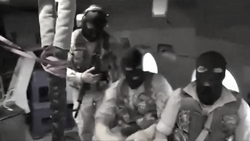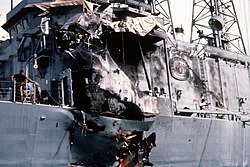1983 Solarian Sea Crisis
| 1983 Solarian Sea Crisis | |||||||
|---|---|---|---|---|---|---|---|
 The CN Tapahanek listing following the Zorasani air attack | |||||||
| |||||||
| Belligerents | |||||||
|
|
| ||||||
| Commanders and leaders | |||||||
|
|
| ||||||
| Strength | |||||||
|
Second incident:
Third Incident:
|
First incident:
Second incident:
Third incident:
| ||||||
| Casualties and losses | |||||||
|
31 killed 78 injured 1 frigate heavily damaged 2 aircraft destroyed |
18-29 killed or injured 18 aircraft destroyed 8 aircraft damaged 2 S-75 batteries 1 Kub battery | ||||||
| 1 civilian freighter seized, later returned | |||||||
The 1983 Solarian Sea Crisis was an eighteen day military confrontration between the Union of Zorasani Irfanic Republics and Halland that took place between 10 and 28 April 1983.
The crisis began with the seizure of the MS Solar Intrepid, a civilian frieghter under the Hallandic flag, accused by the Zorasani government of smuggling weapons to Irvadi separatists. This was denied by the Hallandic government. In response, Halland dispatched several naval vessels to patrol the Solarian Sea shipping lanes and to protect other Hallandic-flagged vessels. On 14 April, the CN Tapahanek was attacked by a single Zorasani aircraft, striking the vessel with two Kh-35 missiles, killing 27 sailors and injuring 78 others.
This led to the deployment of Halland's 1st Carrier Strike Group led by CN John Astor, which arrived off the western coast of Tsabara on 25 April. On the early morning of 26 April, the CSG launched an airstrike against the airbase blamed for the Tapahanek attack, in the ensuing operation, John Astor launched aircraft struck the Ain Samad Airbase, destroying 12 aircraft and damaging 8 more and killing between 30 to 80 personnel. A air battle between the egressing carrier air group and Zorasani air force aircraft saw a further five shot down, while Halland lost two aircraft.
The crisis was formally resolved the next day, with the withdrawal of the 1st Carrier Strike Group and the start of high-level bi-lateral talks between the Hallandic and Zorasani governments. The MS Solar Intrepid was returned with its crew and both sides agreed to monetary compensation for the military personnel killed during the crisis. The events proved highly consequential to both governments, with Halland's military prowess and capabilities confirmed, while Zorasan's military would go on to begin a decades long modernisation and reform process.
Background
Hallandic involvement in Zorasani unification
Tensions between Zorasan and Halland had existed prior to 1983, primarily over Halland’s involvement in assisting states opposed to Zorasani unification, led by the Union of Khazestan and Pardaran. Much like the Euclean powers, Halland’s involvement had peaked during the 1960s, with materiel and training support for the militaries of the Badawiyan monarchies. Between 1952 and 1974, Halland provided significant support to the Riyhadi Confederation, including the sale of equipment, aircraft and even naval vessels.
From 1952 until 1965, Halland’s presence in Riyadha was limited to merely logistical support and officer training. Halland’s involvement coincided with Estmerish missions to the small state aimed at building up the Emirates’ ability to defend themselves militarily against the superior forces of the UKP. On average, the number of Hallandic personnel in the country rarely exceeded 200, yet on occasion these personnel became the targets of the Pan-Zorasanist group, the Black Hand. In one such incident, 3 Hallandic army trainers were killed when the Black Hand bombed the Royal Palm Hotel in At-Turbah on 19 June 1961.
During the Badawiyan War, in which Riyadha as part of the Mubaraz Pact fought against the Union of Khazestan and Pardaran, Halland alongside Estmere maintained a steady and uninterrupted supply of materiel to At-Turbah, leading to many historians crediting both states to keeping the confederation in the war and able to survive a succession of UKP offensives. With the Pact’s defeat in 1968, Euclean and Hallandic diplomatic support succeeded in maintaining Riyadha’s independence, however, in turn it forced the country in ever increasing reliance upon its allies for economic and political stability.
Al-Thawra Uprising
Following the defeat of the Irvadi People's Republic in the Irvadistan War, the country was governed by a Zorasani-backed Revolutionary Provisional Government, who's primary objective was to ready the country for ascenion into the Union of Khazestan and Pardaran. In 1980, the IRPG oversaw Irvadistan's unification with the UKP, to form the modern day Union of Zorasani Irfanic Republics. The IRPG's narrow mandate forced UKP occupation forces to confront the remnants of Irvadi nationalism. However, the swift collapse of the Irvadi military in 1979 allowed many officers and soldiers to desert and enter the general population, where they rapidly became galvinised against the IRPG and UKP occupation. Poor record keeping by Irvadi state institutions denied the UKP the ability to identify and track former soldiers and became ever reliant on human intelligence or the cooperation of the local population.
Between 1980 and 1983, numerous former IPR officials and military officers coalesced to establish the Al-Thawra (The Free) underground resistance movement. Initial actions against the IRPG and UKP was limited to sporadic bombings and gun attacks in cities, with Al-Thawra struggling to secure a sustainable supportbase owing to the immense "war weariness" of the Irvadi population.

In February 1983, the Al-Thawra began mass attacks against UZIR positions in the cities of Jazrah, Rajjan and Hazaza. Attacks in Zubajda were ruthlessly crushed by UZIR forces, where an estimated 3,400 people were killed over the course of two weeks. By late February, Al-Thawra was crushed in Jazrah, but established strongholds in Assan and several districts of the capital, Qufeira. In rural areas, Al-Thawra established smaller strongholds in the central region between Rajjan and Hazaza, where they continued to harass government forces. Between February and April, the UKP forces worked to determine Al-Thawra’s supply routes, searching both border regions and ports for smuggling operations, to some degree of success.
On April 3, Zorasani military intelligence, operating on information from Al-Thawra discovered a maritime supply route from Tsabara and the global black market, where weapons were being smuggled into Irvadistan aboard civilian freighters. This breakthrough is widely believed to be the origin of the decision to seize the Solar Intrepid, with Zorasani government officials citing evidence of seaborne supplies for rebels.
Events
Solar Intrepid Seizure
Following several instances of Zorasani port authorities seizing caches and shipments of weapons in Qufeira, the Zorasani military announced plans to step up observations and intelligence of foreign shipments to Irvadi rebels. According to official government statements, a series of raids against rebel cells in the Irvadi capital led to confessions and evidence of an impending arms shipment, a series of conflicting ship names were provided but through cross referencing by Zorasani military intelligence, they concluded that the ship was the Solar Intrepid, which was schedueled to dock at the same time and date provided by the detained rebels.
The decision to seize the vessel was made by the highest echelons of the Zorasani military on April 8. The military, according to official records, deployed special forces (squads from the 12th Takavaran Regiment) to Qufeira International Airport by the end of the same day.
The Solar Intrepid was a Hallandic flagged vessel operated by Avalon Seaway, a prominent shipping company with extensive contracts across northern Coius. The company, as well as the Hallandic government counter argued Zorasan’s position, by detailing that the Solar Intrepid’s primary cargo was construction machinery, concrete and electricals, common exports to Zorasan during its post-unification reconstruction period. The vessel had a crew of 27, mostly drawn from across South Asteria, it was captained by Alessandro d’Campo, a Mariranan with twenty-years’ experience.
On the morning of April 10, the vessel crossed into Zorasani territorial waters at 09.33am and registered its position with the Qufeira Port Authority. At 10.39am, and approximately 18 miles off the coast, the vessel was buzzed by a Zorasani Army two Mi-17 helicopters, On 20 July, the Hallandic-flagged freighter was seized in a raid by Takavaran forces. The two helicopters stopped the ship and Zorasani commandos rappelled on board from the helicopters. The crew received the Zorasani commandoes peacefully, who ordered the ship to about-turn toward Qufeira. The ship was taken to the military port at Qufeira and its crew of 27 detained on board. The vessel was moored in the military port and on April 11, a vast array of weapons, boxes of ammunition and explosives were presented on state media, with the Zorasani government openly accusing Halland of "funding, arming and supporting terrorism, separatism and violence in the Union."
CN Tapahanek Attack
On 14 April CN Tapahanek, a Gearing-class frigate, was on patrol approximately 11km north of Zorasani territorial waters, maintaining a presence to deter further seizures of vessels, following numerous Zorasani warnings that any freighter could be halted and inspected. The frigate was captained by Captain Gavin Walters, who had 19 years of experience. The Tapahanek was patrolling under the Navy’s operational assumption that Zorasan would not take any military action against Hallandic military assets, let alone civilian assets with naval vessels in theatre. This assumption was further reinforced by intelligence analysis by the Commonwealth Intelligence Service. As a result, the Tapahanek was on patrol with low-level combat readiness.
At 11.31am, a single SAI GR-7 fighter-bomber aircraft was on patrol inside Zorasani airspace, it detected the Tapahanek at 11.49am and changed course for intercept. Approximately three minutes later, the aircraft’s QR-10A fire-control radar locked onto the Tapahanek. At 11.32am, Captain Walters was informed of the lock-on and attempted to contact the aircraft but with no reply. At 11.34am, the Zorasani aircraft fired its two Template:WP anti-ship missiles at a range of 29km. The Tapahanek’s ESM and search radar failed to detect both incoming missiles, which approached the vessel between 5-10 meters above the sea surface. The first missile struck the Tapahanek just forward of the helicopter hangar at the stern on the portside, however it failed to explode, leaking fuel ignited sparking a large fire, which was quickly doused by hangar crew members.
The second missile also struck the portside, several meters above the waterline, below the bridge. The missile detonated, leaving a 10 by 15ft hole in the hull. The explosion also caused damaged to the superstructure above the entry point, disabling electronics, knocking out the vessel’s vital surface-to-air defence system. With no local air support, the Zorasani aircraft was able to return to base unhindered and unharmed.
At 12.05am, Captain Walters ordered a distress signal broadcast to other Hallandic vessels in the area. The captain also ordered the starboard side flooded to keep the hull breach above water, this was vital in preventing the ship from sinking. The distress call was received by the CN Kearsarge and the Etrurian frigate, EMS San Giovanni, both of which were in the area.
Operation Narwhal
Following the heavy damage caused to CN Tapahanek and the subsequent ship's internment in Etruria, the Commonwealth Navy immediately mobilized forces from the 1st Fleet, assigned to the Vehemens Ocean, towards the Solarian Sea. The Carrier Strike Group sent was later joined by the Etrurian MM Santa Cecilia and MM Santa Caterina destroyers on its way. News of the mobilization came to the attention of the government of Zorasan, along with a formal demand on behalf of Halland's government to immediately return the apprehended civilian vessel, compensate the material damage and lives taken by the attack and formally apologize. Zorasan's government denied any response, intensifying patrol of its territorial waters.
On the night of 25 April, Task Force 17 and its Carrier Strike Group, composed of aircraft carrier CN John Astor, escorted by CN Gerald Perry and 4th Destroyer Squadron arrived at the western coast of Tsabara. Without official Zorasani government response, Halland's government authorized a tactical retaliatory strike against Ain Samad airbase. The attack would be done in two waves at rapid succession, with the objective to suppress air defences and neutralize the airfield. At 4:13 AM 8 F4G from VFA-13 took off, flying through Tsabara's airspace at low altitude, armed with anti-radiation missiles. Soon after, at 4:20 AM, 12 F10G2 strike fighters from VFA-11, which recently replaced the previous air defense specialized variant in the squadron, took off armed with Vixen 3 missiles and guided bombs. Shortly after an early warning and control aircraft took off, flying at a 20km radius orbit in international waters in the vicinity of Zorasani airspace.
The SEAD operation undertaken by VFA-13 flew through Tsabaran airspace at low altitudes, with the aircraft ingressing Zorasani airspace at 5:22 AM. The eight aircraft, divided into two flights of four aircraft each were tasked with rapid destruction of Ain Samad's stationary air defense batteries. Low altitude flight and coordinated Wild Weasel tactics allowed for the rapid destruction of the airbase's radars, two S-75 batteries and one Kub battery. The airbase quickly initiated a scramble, calling for the takeoff of all fighter aircraft on station - the majority of which were SAI Asefeh aircraft. Before any interceptor could take off to catch the egressing aircraft from VFA-13, VFA-11 was already ingressing with 12 aircraft, dropping over 18 tons of bombs in the airfield in a span of 5 minutes. The first attack caused a large sized crater in the center of the runway and destroyed one fighter taking off, effectively blocking the runway from use. Subsequent attacks destroyed hangars, destroying 12 more aircraft and damaging further 8. Casualties reported by the government of Zorasan were four deaths and at least 11 injured at the time of bombing. One pilot was killed and 3 maintenance workers, with most injured being workers in the airbase. The use of guided munitions was, according to Halland's press release announced the same day, to minimize collateral damage and ensure the "tactical nature of the retaliation to prevent further capability of aggression on behalf of Zorasan's government while minimizing effects on unrelated personnel".
Following VFA-11's egress, bearing southwest before turning back northwest to its carrier, the Zorasani Irfanic Revolutionary Air Force ordered interception of the strike force from two vectors. The 115th squadron, equipped with 12 new SAI H-09 Asefeh fighters manned by veterans of the Irvadistan War took off from Gharaf Air base, while 12 more SAI H-03 interceptors from 19th squadron took off from Hazaza. The F10G2s managed to outrun the older and slower SAI H-03, whose interception vector was not in their favour. However, VFA-11 met with 115th squadron at 6:04 AM. The larger radars from the F10G and longer range missiles gave them an initial advantage, with three H-09s shot down in the initial exchange, and one F10G shot down. One H-09 pilot, Maj. Hamid Adavazdari, managed to succesfully eject after being shot down, while the others were killed in action.
Orders for VFA-11 were explicit on mantaining route, given the aircraft were operating at maximum range capacity, with little loitering time. Disobeying orders from the Flight Leader, Captain Henry "Badger" McDale and his RIO, Rudraigh "Puffin" McDuffin, lost formation and remained in the combat zone, succesfully shooting down two more H-09s, one of which with the aircraft's cannon as the missiles had already been used. The F10G was shot down by Third Lt. Masoud Karimpour, with both airmen killed in action. The faster F10Gs managed to escape the other interceptors, which were delayed by McDale.
McDale's death was largely controversial in the media and also inside the air force. He was not condecorated at the time, with high command deciding that his unilateral actions were imprudent. This sparked large debates in public opinion, with McDale's story growing quite popular and told in many news sources. McDale and McDuffin would be in 2005 rewarded with the Medal of the Nation's gratitude for their sacrifice.
Aftermath
Standoff
Immediately after CN Tapahanek’s attack, Halland recalled all diplomatic personnel from Zorasan, issuing a recommendation for all Hallandic citizens in Zorasan to leave the nation if possible. Zorasan retaliated, recalling diplomatic personnel following the escalation of tensions the next day. The airstrike in Ain Samad escalated the diplomatic tensions even further, with a declaration of war from Zorasan having been drafted, according to numerous internal sources.
On 28 April, following internal and international pressure, both nations agreed in bilateral talks to end the standoff. In the meantime, the crew of the Solar Intrepid had been imprisoned in Zorasan, being held at the Beit Samir Prison near Qufeira. Following bilateral talks on phone held by Hallandic and Zorasani Heads of State and a series of telegrams, the crisis and risk of war was averted, with Hallandic President James Wynn releasing a pronunciation to the press the same day that “Zorasan was taking steps to amend the mistakes they committed.” The Zorasani government also released less hostile statements, saying, “having shown the Hallandic government our resolve, we are prepared to discuss mutually beneficial means of avoiding any further disputes.”
Normalization of Relations
The morning of the following day, the Zorasani and Hallandic governments declared that an agreement had been reached, with Zorasan releasing the crew of the Solar Intrepid along with the ship, stating a formal apology for the initiation of aggression and paying substantial reparations to the Hallandic families of those wounded and killed in the CN Tapahanek attack. Halland reciprocally apologized to the families and sent reparations to casualties of the airstrike. Material reparations were not given by either side, and Zorasan never returned the cargo of Solar Intrepid. Despite this, the concessions were viewed positively in Halland, and relations between the two nations slowly normalized with diplomats being sent once again the following week.

While the government of Zorasan issued a statement showing the seized weapons brought by the Solar Intrepid, Halland disputes the claim as forgery and propaganda, with the crew members independently stating that the ship indeed did not carry armament. While Zorasan sustained their claim of weapons, shortly the use of the event in propaganda was mitigated.
Reports from former Hallandic intelligence personnel and retired Zorasan diplomats state that the unusual concessions of Zorasan were given in exchange of Halland removing its unofficial material and financial support of Irvadistan’s armed movements. This was never confirmed by Halland, with all intelligence and military documents of the affair remaining classified.
Impact

Operation Narwhal was considered by many military specialists an example of Halland’s projection capacity, with the country able to conduct aerial and naval operations beyond their territorial waters and adjacent seas largely with assets of their own. While the initial attack on CN Tapahanek was viewed as a great success by the government of Zorasan, who put their anti-ship defence network to test and showed the world its effectiveness, the attack on Ain Samad caused the High Command of Zorasan to significantly improve its air defence network and increase the readiness rating of its air force. The incident also provoked major changes to the leadership of the Zorasani air force and air defence, ultimately leading to the ongoing modernisation and reform process, beginning in 1985. In 1984 it was remarked during reforms and changes to the air defence doctrine, a common refrain among senior officers was "1983 can only happen when we are all dead." As of 2019, some Hallandic military analysts have claimed that Zorasan's air defence today is "in no way the same as it was in 1983 - in short, Narwhal couldn't be repeated today without serious consequences." Despite the international attention garnered for the Irvadi rebel cause, Zorasani military operations would defeat the uprising by 1984. Commentators during the Saffron Era noted that Operation Narwhal had "inflicted a heavy punch to the military's self-confidence and caused serious self-reflection among the highest ranks." In subsequent months, the Zorasani government began to remove all references to the incidents from public record which continues to this day. Unlike Halland, there is no public commenoration for the pilots or ground crew killed during the Hallandic counter-strike and there remains no significant marking of the event at annivarseries.
Claims by Zorasani government officials during the 1990s revealed that the incident had proved devastating the standing of State President Javad Jahandar, who’s handling of the entire episode raised criticisms of his leadership among senior circles of the Zorasani military. His intention to remain in office beyond 1985 was effectively eliminated by the events of the preceding months. In Halland, President Wynn's dealing of the event and display of Hallandic projection capacity was well received by the general public, despite vocal opposition of the event, which still raised severe controversy. Wynn's handling of the crisis were a large faction in his subsequent reelection and the continuation of his party's majority.
The event was popularized for the public in the movie “Hornet’s Nest”, depicting the events of Operation Narwhal from the perspective of Captain McDale.




